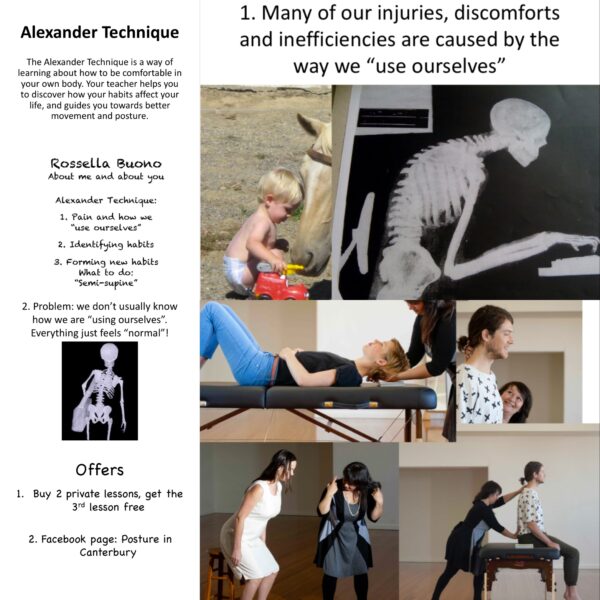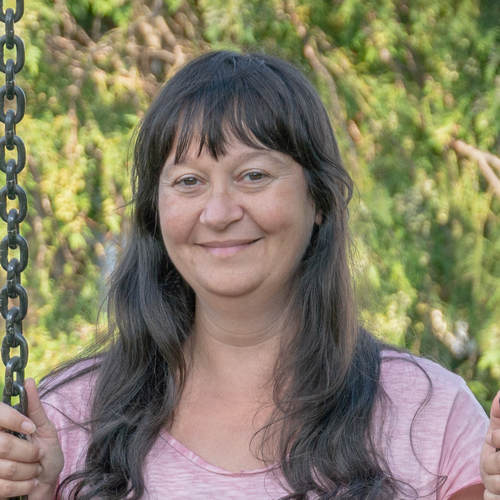Event Details
This How-to has already taken place.
Rossella Buono
Kent,
United Kingdom
How To give a talk
Some people are just amazing. They can transform the driest of subject in a fun learning experience, or engage you so deeply you loose track of the time. Think of your favourite teacher from high school, a TED talk you love, or a presentation you still remember years after. How did they do it? How do we do it with the Alexander Technique? How do we adapt to different audiences, numbers, lengths and environments? How do we stay clear and adaptable?
Based on a Degree in Literature and Philosophy with dissertation, lots of attending and giving talks, a university professor husband happy to share his knowledge and an intense wish to get the Alexander technique out there, this How To will bring examples, share physical activities to attract attention, make sense and to keep people involved and exploring. Some embarrassing disasters will be shared too.
Here to follow an example of a talk for a Health Clinic specialising in pain management. I had 40 minutes. Those were my notes. Let’s find all it’s wrong with it.
Hi, thanks for coming and thanks to X&Y for having /inviting me here.
Today I’m going to introduce myself (A)
what I do (B)
and what is in it for each of you (C).
A) My story, Alexander’s story and my qualification (not everyone knows we study 3 years full time)
The AT is very popular for people with X and very effective in Y, I have worked with ….
Let’s see how many of you are in pain right now? How many have had pain in the last 10 years? So what happened?
B) what I do
There are 3 key points in that first sentence and you’ll soon know everything about it.
(picture 2) We will look at what I mean when I talk about the use of the self, will see what habits are, how to see them and how the AT goes on getting rid of unnecessary stuff and developing new habits, while dropping the ones that are not helping.
1)Picture 3 – How do we go from this to that? Is it inevitable? My back is killing me! Pain and how we “use ourself”. I like this idea because I find it very empowering: Many of the pain, injuries and discomfort we experience as happening to as are actually caused by things we do to (or with) ourself. There is not one way to perform a common action.
Do you know how heavy the head is? 5 kg BAG –Collateral injuries. We accumulate and collect all sort of habits in the years
New York spine surgeon Jack Stern in the Lugano conference in 2011 was saying that 4 out of 6 of his patients’ back pain is postural, not structural or disease related.
2008 British Medical Journal Study – Paul Little- Southmpton.
Randomized controlled trial of AT, exercise and massage for chronic and recurrent pain proved on a 500 people sample 6 to 24 AT lesson were still very effective over a year later.
2) Identifying habits Picture 4
The AT identifies and makes visible the habits we have developed that may be causing stress/pain
For the AT to be a way of being comfortable in your own body we need to be able to see those habits. Why is this necessary? Normal and Habitual – arms crossed.
Wrong/right stimulus – response
3) Make new habits (Picture 5)
The AT changes the habits to ones that won’t result in pain and allows you to move freely and easily – Standing or chair work
Take home the semi-supine, you learned it, it’s a present.
Summary: so we talked about (picture 2)
C) and what is in it for each of you. Picture 6 & 7

About Rossella Buono
Rossella, born in Italy in 1975, lives and works between her adoptive home in the UK, Italy, and Australia, where she trained with David Moore in Melbourne.
As well as running a successful practice as an Alexander Technique teacher in Canterbury, UK, and online, Rossella also teaches the technique at the School for FM Alexander Studies in Australia.
Rossella is the author of For the Love of Games with Anne Mallen, with beautiful illustrations by Melbourne artist Isobel Knowles. This collection of games and activities, part original and part collected over the years, offers a resource for AT teachers to begin working with groups, or add depth and variety to an existing group-based practice.
Rossella is also the co-creator and co-curator of Authors – not your Usual Book Club with Jana Boronova, and assistant to David Moore’s Smart Yoga and AT training courses in Melbourne. A keen proponent of collaboration, she has worked with Luke Hockley to offer the workshop Learning How to Learn, Jeremy Chance’s AT Success course and many more.
Her interest in training courses has taken her to New York, Germany, Ireland and all over the UK, to share work and present on the topics of marketing, activities, anatomy, working with groups and social media.
Rossella has a gift for organising, a dynamic personality and a down to earth approach to things, allowing her to join the dots leading to new content and collaborative projects. She sees the Alexander Technique as an effective and sustainable model of personal and social development. Bringing an inclusive and practical spirit to all her activities, Rossella aims to realise the Technique’s value as a resource to as many people as possible.
rossellabuonoat@gmail.com
http://rossellabuono.com/
See also: Rossella Buono – Presenter Detail Page
How-to
Friday, 26 August 2022
15:00 h - 17:00 h (3.00pm-5.00pm)
Main Building
Floor: 2.OG (2nd floor)
Room: H 2037
CATEGORIES
AT Principles and Procedures||Practical Teaching Skills||AT Games||Communication/Verbal Skills||Connections to other Modalities/Techniques||Business / Marketing
3
WORKSHOP STYLE
Fully Practical
Lecture
OPEN FOR
Teachers||Trainees||Everyone

